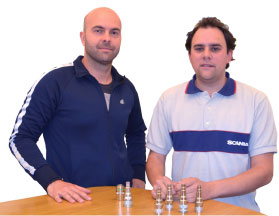CEJN Assists Scania with Optimisation

SCANIA’s engine production site in Södertälje, Sweden is an impressive facility. As a visitor you are immediately struck by the positive energy in terms of both cooperation among the staff and the appropriate layout of the site. The sites in Södertälje houses 9,000 employees involved in manufacturing, development, testing and painting diesel engines among other things. This advanced chain incorporates a specially designed CEJN fuel nipple facilitating the testing of diesel engines.
Global company SCANIA has a total workforce of 42,000 and is well known for its trucks and highly-developed production chain. Volumes are currently at peak levels, and according to SCANIA themselves part of this success has to do with early adaptation to meet differing emission requirements around Europe. One example being EURO6. “We made major investments early on and that is now paying off and we are prepared for the future,” explain Björn Davidsson and Sinisa Jakovljevic, Process technicians at SCANIA. Their role is to plan future functions, support the production cells with equipment and find solutions for optimising the production line. And talking of optimisation, that’s where CEJN comes in.
Nipple for engine testing
SCANIA calls it the fuel nipple. It is a custom-made non-drip solution from CEJN, including both a male and one female component, which has provided SCANIA with a leak-free solution in their engine testing cells. It connects directly to the engines in the test cells and serves as the most important connection point. As SCANIA produces 300 engines a day, this sealing feature is highly important. “With 90 engines rolling through the chain we simply cannot accept any leakage in the test cells that might create slip hazards, dirt or catch fire. That is why we have chosen CEJN,” says Björn.
|
Sinisa Jakovljevic & Björn Davidsson, |
Air pockets eliminated
Moreover, the fuel nipple is also providing additional positive side effects during engine testing that SCANIA did not expect. Getting rid of all the air pockets in the system when filling up with diesel used to be a time-consuming task. However, due to the sealing function of the fuel nipple SCANIA is now able to create a vacuum in the fuel system, ensuring a quick and smooth filling process. The sealed vacuum also creates back flow that speeds up the process. “This saves a lot of time and money,” states Sinisa.
Development cooperation
The partners started working together in 2005 and since then modifications have been made to optimise the “Fuel Nipple” even further. “We are very happy with the product. It exceeds expectations and is a cost saver for us,” says Björn. However, there is always room for improvement and the partners are now in the process of developing new optimised versions and sizes of the nipple. Another target is to facilitate and optimise the cleaning process inside the coupling.
“As an engineering partner it is very important to listen to the customer in order to find new ways to adapt the design,” says Henric Karlsson, Key account manager at CEJN Norden AB, and continues: “It is very satisfying for CEJN to have been part of such an improvement for a customer like SCANIA.”
